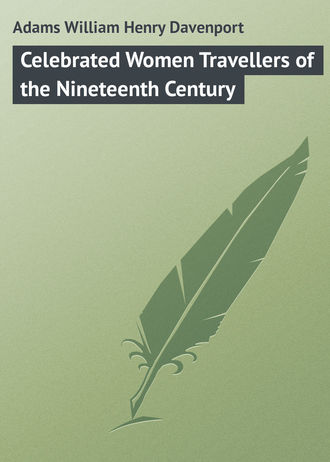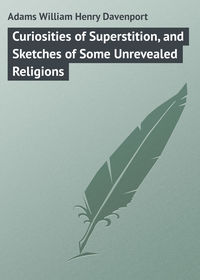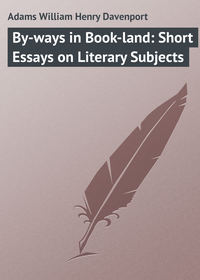 полная версия
полная версияCelebrated Women Travellers of the Nineteenth Century
In the young Princess Morosi, the daughter of the Aga Assaki, afterwards married to Edgar Quinet, Madame de Hell learned to know and love a charming wit and a rare beautiful nature. She studied the French poets with assiduity, and her great ambition was to visit France, little thinking that she would one day become French by her marriage with the illustrious French writer.
In the Caucasian steppes our traveller's life had been singularly calm and serene; in Moldavia it was agitated and disturbed by mundane occupations, by official receptions, balls, concerts, dinners, the theatre, and the thousand and one responsibilities of social life. Worn and weary with the monotonous round of pretended pleasures, she frequently looked back with regret to the solitudes of the Caspian. Yet the event which delivered her from it was one that caused her a very keen anxiety. Her husband was attacked by one of the malarious fevers of the Danube, and in order to recover his health was compelled to throw up his engagement and return to France, after some years of almost constant travel and exploration.
On their arrival they were received with the welcome earned by their patience of investigation and strenuous pursuit of knowledge. While the young and already celebrated engineer was rewarded with the Cross of the Legion of Honour, his wife, who had shared his labours and his perils, and co-operated with him in the production of his fine work on the Steppes, was honoured with the special attention of M. Villemain, then Minister of State. Shortly after her return she gave to the world a volume of poetry, entitled "Reveries of a Traveller," a work strongly written, thoughtful, and emotional, which has never obtained the reputation it fully deserves.
In 1846 the two travellers departed on a second expedition to the East, which was cut short by the premature death of M. de Hell. His widow returned to Paris towards the close of 1848, so crushed beneath the calamity that had overthrown her household gods, that, as she has since acknowledged, she never slept without the hope that her sleep might know no waking in this world, but might prove the means of re-uniting her with her beloved husband. However, she was of too clear an intellect and too strong of heart not to recognize that the ties of duty bound her to this world; she had to bring up and educate her children, and to complete and publish the important works her husband had begun. While thus engaged, she contributed several articles on the East to the Presse and numerous other journals. In 1859 she published her own narrative of adventure and travel in the steppes of the Caucasus. Great political changes have occurred since Madame de Hell's visit to that region, which have profoundly affected the character of its people and their social polity; so that her account of it, as well as her account of the Crimea, must be read with the necessary allowances. These, however, will not detract from Madame de Hell's unquestioned merit as a close and exact observer, endowed with no ordinary faculty of polished and incisive expression, and a fine capacity for appreciating and describing the picturesque aspects of nature. She wields a skilful brush with force and freedom; her pictures are always accurate in composition and full of colour.
Her later years have shown no decay of her resolute and active spirit. She has accomplished a tour in Belgium, another in Italy, a visit to London, and several excursions into the South of France. In 1868 she proceeded to Martinique, where her eldest son had for some years been established. We believe she has published her West Indian experiences and impressions. But we have given up to Madame de Hell as much of our limited space as we can spare, and now take leave of her with the acknowledgment that among modern female travellers she deserves a high rank in virtue of her intelligence, her sympathies, and her keen sensibility to all that is beautiful and good.
MADAME LÉONIE D'AUNET
Among the crowd of lady travellers to whom this nineteenth century has given birth, the able and accomplished Frenchwoman, so widely known by her pseudonym of Madame Léonie d'Aunet, merits a passing allusion. Remove from her the mask she is pleased to assume before the public, and she stands revealed as Madame Biard, the wife of the great humoristic painter, whose "Sequel of a Masquerade," "Family Concert," "Combat with Polar Bears," and other pictures, are not less highly esteemed by English than by French connoisseurs. Born about 1820, she is twenty years younger than her husband, whom, in 1845, she accompanied in his excursion to Spitzbergen; an excursion which opened with, by way of prologue, a rapid tour through Belgium, Holland, Sweden, and Norway. Of the tour and the excursion she has published a brilliant narrative, which it is impossible to read without pleasure, so polished is the style, and so sharply defined are the descriptions. Her literary skill gives her an advantage over the great majority of female travellers, whose diaries and journals, from want of it, are often bald, colourless, and diffuse. On the other hand, she is deficient in sympathy; she judges rather with the intellect than with the heart, which is at least as necessary to the formation of a fair and intelligent opinion. Her mind, however, is so keen and so incisive, so prompt to seize the most curious facts, so apt in discovering characteristic details, that even when she speaks of places and peoples with whom we are all familiar, she compels us to listen, and irresistibly holds our attention. It has been said that in some respects her manner is that of the elder Dumas, but while she is more honest and less given to exaggeration she does not rise to the same literary standard. The famous author of "Anthony" is still first master in the art, more difficult than the world in general believes it to be, of recording the experiences of travel; he is a master in it, because he does not make the attempt, which must always be unsuccessful, of minutely recording every particular that comes under a traveller's notice, and because he is gifted beyond ordinary measure with the art and verve of the raconteur. Persons and situations he knows how to group in the most effective manner; incidents assume their most dramatic form; scenes are worked up so as to produce a definite impression on the reader's mind.
Madame d'Aunet, as a popular novelist, knows when writing that she can count upon her thousands of readers. But this is a fact which we wish she could have forgotten or ignored. For, keeping it always before her, she is led to weigh with critical timidity every word, every phrase, and to elaborate each sentence until, in the old Greek phrase, we "smell the oil." Those passages of glowing description which at first marched on so freely and fully, come to an abrupt pause. The language, formerly so vigorous and incisive, becomes vague, colourless, hesitating; or, very frequently, gets upon stilts and assumes an air of pretentious affectation. The writer has evidently forgotten, in her over-scrupulous regard for the artistic and picturesque, that nothing is so attractive as simplicity. And Madame d'Aunet is always most charming when she is most natural – that is, when she is herself; when she writes spontaneously, and fully possessed by her subject, without casting anxious glances at the reader to see if he admires this polished period or catches that apt allusion. Therefore, we are compelled to indicate as a defect – which, if not very great, might as well have been avoided – a certain affectation and coquetry of style, displaying the solicitude of the artist rather than the frank simplicity of the story-teller. Something of this fault the English reader notes in Mr. Kinglake's "Eöthen."
In speaking of Belgium and Holland, Madame d'Aunet lets drop some felicitous expressions, some pregnant and rememberable phrases, which give the reader an exact idea of the manners of the inhabitants and of the land they dwell in. The touch is delicate, but always firm and true.
As to the Hollanders, she says: —
"These people have not the love of cleanliness, but its cultus."
Referring to the two Dutch towns which are the most rigorously watched over, she says: —
"Saardam is a page, and Broek a vignette, from the history of Holland.
"The people of Broek have neither the taste for, nor the love of, cleanliness; it is with them a fanaticism, a fetichism. A certain means of ensuring from them a favourable reception is the avoidance, not of vices, but dirt."
In Norway, Madame d'Aunet visited Christiania, Drontheim, and other localities; but it is Man rather than Nature that interests her. Nor did she penetrate far enough inland to gain a satisfactory conception of the character of the Norwegian scenery. In the heart of the Dovrefeld Mountains are grand and sublime landscapes of peak and ravine, cataract and forest, not inferior to the most famous scenes in Switzerland. Norway can boast of the finest waterfall in Europe: that of the Maan-ily, or Riukan-foss, which is as majestically beautiful as the cascade of Gavarni or the falls of Schaffhausen – which, indeed, has sometimes been compared to Niagara itself.
Mons. Gainvard's expedition quitted Hammerfest, the northernmost town in Scandinavia, and after a voyage of some weeks in duration, approached the gloomy coast of ice-bound Spitzbergen. The ice-fields and the icebergs inspired Madame d'Aunet with profound emotion, and, in describing them, she breaks out into what may be called a lyrical cry. "These Polar ices," she exclaims, "which no dust has ever stained, as spotless now as on the first day of the creation, are tinted with the vividest colours, so that they look like rocks composed of precious stones: the glitter of the diamond, the dazzling hues of the sapphire and the emerald, blend in an unknown and marvellous substance. Yonder floating islands, incessantly undermined by the sea, change their outline every moment; by an abrupt movement the base becomes the summit; a spire transforms itself into a mushroom; a column broadens out into a vast flat table, a tower is changed into a flight of steps; and all so rapidly and unexpectedly that, in spite of oneself, one dreams that some supernatural will presides over those sudden transformations. At the first glance I could not help thinking that I saw before me a city of the fays, destroyed at one fell blow by a superior power, and condemned to disappear without leaving a trace of its existence. Around me hustled fragments of the architecture of all periods and every style: campaniles, columns, minarets, ogives, pyramids, turrets, cupolas, crenelations, volutes, arcades, façades, colossal foundations, sculptures as delicate as those which festoon the shapely pillars of our cathedrals – all were massed together and confused in a common disaster. An ensemble so strange, so marvellous, the artist's brush is unable to reproduce, and the writer's words fail adequately to describe!
"This region, where everything is cold and inert, has been represented, has it not? as enveloped in a deep and sublime silence. But the reader must please to receive a very different impression; nothing can give any fit idea of the tremendous tumult of a day of thaw at Spitzbergen.
"The sea, bristling with jagged sheets of ice, clangs and clatters noisily; the lofty littoral peaks glide down to the shore, fall away, and plunge into the gulf of waters with an awful crash. The mountains are rent and splintered; the waves dash furiously against the granite capes; the icebergs, as they shiver into pieces, give vent to sharp reports like the rattle of musketry; the wind with a hoarse roar, scatters tornadoes of snow abroad… It is terrible, it is magnificent; one seems to hear the chorus of the abysses of the old world preluding a new chaos.
"Never before has one seen or heard anything comparable to that which one sees and hears there; one has conceived of nothing like it, even in one's dreams! It belongs at once to the fantastic and to the real: it disconcerts the memory, dazes the mind, and fills it with an indescribable sense of awe and admiration.
"But if the spectacle of the bay had something magical in it, ominous and gloomy was the scene on shore. In all directions the ground was white with the bones of seals and walruses, left there by the Norwegian or Russian fishermen, who formerly visited these high latitudes for the purpose of collecting oil; for some years, however, they have abandoned a pursuit which was much more dangerous than profitable. These great bones, bleached by time and preserved intact by the frost, seemed so many skeletons of giants – the past dwellers in a city which had finally been swallowed up by the sea.
"The long fleshless fingers of the seals, so like to those of the human hand, rendered the illusion singularly striking and filled one with a kind of terror. I quitted the charnel-house, and directing my steps very cautiously over the slippery soil, penetrated inland. I found myself very speedily in the middle of a cemetery; but this time, the remains lying on the frozen snow were human. Several coffins, half open and empty, had formerly been occupied by human bodies, which the teeth of the white bear had recently profaned. As, owing to the thickness of the ice, it is impossible to dig graves, a number of enormous stones had, in primitive fashion, been heaped over the coffin-lids, so as to form a defence against the attacks of wild beasts; but the stout limbs of "the great man in the pelisse" (as the Norwegian fishers picturesquely call the polar bear) had removed the stones and devastated the tombs; a throng of bones strewed the shore, half broken and gnawed … the pitiful remains of the bears' banquet. I carefully collected them, and replaced them piously in their proper receptacles.
"In the middle of this work of burial, I was seized with an indescribable horror; the thought came upon me that I was doomed, perhaps, to lay my bones among these dismembered skeletons. I had been forewarned of the perils of our expedition. I had accepted the warning and fancied that I comprehended all the hazard; yet these tombs made me for the moment shudder, and for the first time I dwelt with regret on the memories of France, my family, my friends, the blue sky, the gentle and serene life which I had quitted in order to incur the risks of so dangerous a voyage."
Madame d'Aunet, however, returned to Paris in safety, and satisfied with her experiences of the Polar world, attempted no second expedition. According to M. Cortambert, to whom I owe this sketch, she afterwards resided in Paris, and edited several journals intended for women's reading. She also produced some works of no inconsiderable merit.
FREDERIKA BREMER
It seems reasonable enough that a good novelist should make a good traveller; for to both is essential the possession of a faculty of quick and accurate observation. Among the novelists of the nineteenth century Frederika Bremer holds a distinguished position; we hope to show that she merits a similar place among its travellers.
She was born at Tuorla Manor House, near Abo in Finland, on the 17th of August, 1801. When she was three years old her father removed his family to the small estate of Arsta, about twenty miles from Stockholm, which he had purchased. Here she received a careful education, early attaining a good knowledge of French, so as to read and speak it with facility. Her literary powers were almost prematurely developed, like those of Charlotte Bronté, and she wrote verses to the Moon at eight years old. At ten she meditated an elaborate poem on no less a subject than "The Creation of the World." But her attention was soon turned to more practical themes, and it is noticeable that even in this early springtime she began to think much upon the dependent and subordinate position to which woman has been so unjustly condemned by society.
She was about twelve when her father took up his abode at Nynäs. Nynäs was an old-fashioned mansion situated amidst picturesque scenery, which appears to have awakened in Frederika her first impressions of the beauty of Nature. Her education still continued; she studied English and German, and made considerable progress in history and geography.
In 1813 Nynäs was sold, and the family once more settled at Arsta. There the young Frederika learned to take a deep interest in the great political events which were then convulsing Europe – in the great uprising of the nations against the selfish tyranny of Napoleon. The patriotic fire burned brightly in her girl's heart. She wept because she had not been born a man, so that she might have girded on her sword, and joined her country-men to fight in the cause of right and freedom. A strong desire possessed her to become a warrior; it was, in truth, the bird beating against the bars: the restlessness and activity of a genius which as yet had not found its proper channel of expression. She at one time resolved to flee from home and proceed to the theatre of war, which she imagined would be a matter of no difficulty, and, attired in male costume, to become page to the Crown Prince (afterwards King Charles XIV.), who then appeared to her little less than a demi-god. This scheme amused her fancy for more than a year, and melted away slowly, like snow in water. Gradually her enthusiasm as patriot and warrior declined, and gave way to new and equally strong emotions. Religious fervour, she says, and the most mundane coquetry struggled within her; feelings for which she could not account seemed to beset her young bosom, filling it sometimes with a heaven and sometimes with a hell. "Like two all-consuming flames," she writes, "the desire to know and the desire to enjoy were burning in my soul, without being satisfied for many long years. The mere sight of certain words in a book – words such as Truth, Liberty, Glory, Immortality – roused within me feelings which vainly I would try to describe. I wanted in some way or other to give vent to and express the same; and I wrote verses, dramatic pieces, and a thousand different kinds of essays; composed music, drew and painted pictures, some of them worse than others."
By degrees, society in Stockholm began to appreciate the fact that the Bremer family boasted of a maiden of more than ordinary ability, who, for the family fêtes, composed little dramas of more than usual merit. They engaged the attention of the poet Frauzon, who was frequently present at the juvenile performances, and by his advice helped to form the young dramatist's taste, and correct her judgment. Her earlier efforts were in verse; but after a time she essayed to clothe her thoughts in prose, and in prose of a very vivid and forcible kind. The "Correspondence between Axel and Anna" was her first serious work; so great already was her facility of composition that she finished it in two days and two nights. Her poems did not make their appearance until twenty years later, when they had been revised and corrected by their author, whom experience had taught that polish of style and gravity of language which can be acquired only by the careful study of the best writers.
In the comparatively limited circle to which for several years she was confined, and under conditions of domestic life which were unfavourable to the happy development of her genius, she would have found it very difficult to indulge her literary tendencies, if the Countess Sonnethjelm, a Norwegian lady, had not come to her assistance by providing her with an asylum under her roof. There her powers began rapidly to expand, and she herself to comprehend that literature offered the sphere of action for which she had so ardently longed.
Afterwards, like the authoress of "Jane Eyre," she spent some time as a governess in a ladies' school at Stockholm. We have already hinted that her early life was not altogether happy; her parents do not appear to have understood or sympathized with her, and the household concord was frequently broken by the austere, not to say eccentric, temperament of its head. She says of herself that "a dark cloud came over the splendour of her youthful dreams; like early evening it came over the path of the young pilgrim of life, and earnestly, but in vain, she endeavoured to escape it. The air was dimmed as by a heavy fall of snow; darkness increased and it became night. And in the depth of that endless winter's night she heard lamenting voices from the east and from the west, from plant and animal, from dying nature and despairing humanity; she saw life with all its beauty, its love, its throbbing heart, buried alive beneath a chill covering of ice."
In the summer of 1831 she paid a visit, which extended over a twelvemonth, to a recently married sister, then settled at Christianstadt. We are told that the young novelist had determined not to mix in society or accept any invitations, but to live in retirement, and develop herself for what she now considered to be her mission and her vocation, namely, to become an authoress; and, enriched by experience of the world, to devote her talents in a double measure to the comfort and assistance of the suffering and unhappy.
"Frederika," says her sister,9 "found and felt that she required to learn much, and that she stood in need of a firm religious faith, which she had hitherto lacked. The contradictions which she fancied she saw in the Bible and the world had long shaken her belief, and raised doubts in her soul to such a degree that, at times, with her reflecting and inquiring mind, they seemed to darken life."
The teacher, or guide, for whom she had instinctively yearned, she found at Christianstadt in the head master of the High School, the Rev. Peter Böklin, by whose teaching, example, and character she profited greatly. His influence was as beneficial as it was powerful. Well versed in history and philosophy, he gave a new impulse to Frederika's genius, while his wise and judicious criticism corrected the errors into which spontaneity and facility betrayed her. He showed her that it was not enough to compose with ease, she must learn to think clearly and soundly; and that grace of style and picturesqueness of description were of little avail to the novelist without the creative idea.
Under these changed circumstances a change came over the tone in which she spoke of life. Writing to her mother, in October, 1831, she says: —
"Life seems now to be of value to me. Formerly it was not so. My youth has not been happy; on the contrary, it has been a time of suffering, and its days to a great extent – this is indeed the truth – have passed away in a continual wish to die. But now it is otherwise. As a compensation for that long period of pain and compulsory inactivity, another has succeeded, which gives me the means of usefulness, and therefore also of new life and gladness. We hope – we desire – my sisters and I – nothing else than to be able to do some little good while we are wandering here on earth, and according to the power that is given to us to work for the good of others, and live ourselves in peace and harmony; and perhaps our saddened youth, if it have deprived us of some of the enjoyments of life, may in a certain measure have led our minds to higher aspirations, and to a stronger desire for real usefulness."
Her literary career had begun three years before this epoch. In 1828 she published at Stockholm her "Sketches of Every-day Life" (Teckningar ur Hvardags-lifort), including, "Axel and Anna," "The Twins," and other stories. They met at once with a favourable reception. But it was not until she produced her striking picture of "The H – Family" that the public recognized the full extent and claims of her genius. Her reputation spread with great rapidity, and was extended and confirmed by the works which proceeded in swift succession from her fertile pen. "The President's Daughter," "Nina," "The Neighbours," "The Home," and "Strife and Peace;" all these books are marked by the same general characteristics: entire purity of tone, warmth of feeling, clearness of judgment, insight into human nature, genial humour, a sharp perception of social aspects, a strong, clear style, and unusually vivid descriptive powers. Her plots are simple, and her incidents natural. In fact she seeks them in the ordinary scenes of domestic life, in its joys and sorrows, in the duties and pleasures, the lights and shadows of home – and is never induced to venture into the regions of melodramatic or philosophical fiction.
In 1841 the works we have enumerated were translated into German, to attain in Germany to as great and enduring a popularity as they had acquired in their native country. In the following year they were made known to the British public, through the labours of William and Mary Howitt; and the reception accorded to them was as enthusiastic as could be desired. Their merits, indeed, were precisely those which English readers might be supposed to appreciate.







